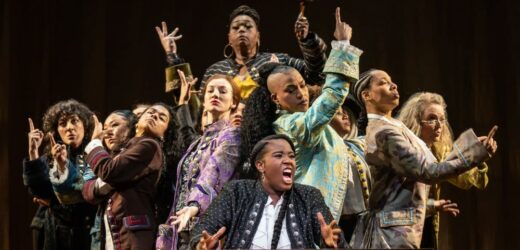The opening moments of this exuberant, thought-provoking and radical revival of “1776” makes it clear who was missing from John Trumbull’s famous painting of the signers of the Declaration of Independence.
As the female, transgender, non-binary and racially and ethnically diverse cast arrives on stage, exchanges street clothes for period waistcoats and literally steps into the black buckled shoes of this country’s forefathers, we know immediately that this will be a theatrical re-imagining not only of history, but the acclaimed Tony Award-winning 1969 musical.
Co-directors Diane Paulus and Jeffrey L. Page apply a bold Brechtian brush to this picture with its casting, staging, musical arrangements and design. Without changing the narrative, it adds layers of context that offer further shadings to the musical, even though at times the results are somewhat crude, clunky or overdone.
It’s worth noting the original conception and musicalization by Sherman Edwards, with a book by Peter Stone, was revolutionary first, both in form, content and narrative accomplishment, all while working within the template of a traditional Broadway musical. But history marches on and so do theatrical tastes, aesthetics and perspectives, and here the presentation is decisively big, busy and, well, declarative. But this, too, is a “1776” worth celebrating.
Co-director Page also choreographs the movement and dance, making its tableaux very vivant — and then some. This “1776” pulsates with energy, snaps with attitude and enlivens history, which take place mostly in the Chamber of the Continental Congress in Philadelphia as these colonial representatives argue about breaking ties with England and constructing what would eventually be a clearly imperfect union.
Obnoxious, disliked and obsessively determined, John Adams (a solid Crystal Lucas-Perry) leads the charge for independence, along with Benjamin Franklin (Patrena Murray, delightful as the scene-stealing sage) and Thomas Jefferson (Elizabeth A. Davis).
The tut-tutting opposition is led by John Dickinson (Carolee Carmello, in brilliant voice) and the other conservatives, deliciously depicted in “Cool, Cool, Considerate Men,” a witty yet chilling highlight once again.
In this new tapestry, some contextual touches work better than others. The addition of dialogue with Abigail Adams urging her husband to “remember the ladies” in the crafting of a new nation is certainly potent. And projections of two centuries of civil activism and protests gives an epic sweep to the otherwise twee “The Egg.” Jefferson’s ownership of slaves is silently and effectively acknowledged with the simplicity of a hesitant brush to the sleeve.
Other choices expand but not necessarily improve upon moments that were already theatrically stunning. While the new choral work in “Momma, Look Sharp” is gorgeous under AnnMarie Milazzo’s vocal design, bringing a literal and awkward Momma on stage for a very long time is not nearly as effective as the one the audience holds in its imaginations and hearts.
Inflating the production values of “Molasses to Rum” only undercuts the dazzling and nuanced acting and vocals of Sara Porkalob as the sinuous Edward Rutledge, in this scathing critique of the New England’s hypocrisy in its involvement in the slave trade. (The repeat of the barrel imagery also loses its punch in its second go-round at show’s end.)
Still, the singing couldn’t be richer with these beautiful, wide-ranging harmonizing voices. Giving the production a cooler, contemporary accompaniment are fresh orchestrations by John Clancy under the music direction of Ryan Cantwell.
The two sole female characters are standouts: Allyson Kaye Daniel shows beautiful restraint and voice as Abigail Adams, while Eryn Leroy as Martha Jefferson also shimmers in the first act-ending “He Plays the Violin” — with Davis actually playing the instrument. But the number is robbed of its pure joy by performing it with leers and orgasms instead of winks and smiles.
Like “Hamilton,” this “1776” allows audience to witness a history anew through an outsider’s eye, as it reframes the classic Trumbull painting in a different light, from a different angle, and offering a more critical perspective, one that inspires, yes, but one that also continues to haunt in its incompleteness.
Read More About:
Source: Read Full Article


